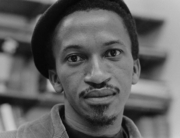
Over the course of a brief but productive career (two novels, 32 short stories, plus letters and other nonfiction published posthumously), Flannery O’Connor (1925–1964) spun darkly humorous gothic tales about self-blinding preachers, girls with wooden legs, intersex carnival attractions, murdering misfits, and other Southern oddities. “She just saw the mystery of the craziness,” says fellow Georgia writer Alice Walker in the illuminating new documentary that probes the life and work of one of America’s most original writers.
The inaugural winner of the Library of Congress Lavinei/Ken Burns Prize for Film traces the influences (Southern roots, Catholic faith, lupus diagnosis) that shaped O’Connor as a writer through a skillful blend of rare archival footage, including O’Connor’s only television interview, animated illustrations of some of her most famous short stories, clips from film and television adaptations of her work, and interviews with friends, relatives, authors, editors, and critics (Alice McDermott, Mary Gordon, Mary Karr, Richard Rodriguez, Hilton Als, Robert Giroux). One wonders, however, at the inclusion of comedian Conan O’Brien and actor Tommy Lee Jones among the talking heads. What is their connection to the writer? (The press notes explain that both men wrote their Harvard undergraduate theses on O’Connor.)
Among the surprising revelations is O’Connor’s talent as a cartoonist. Friend Sally Fitzgerald notes that O’Connor wanted to be a serious writer who would support herself with her drawings. “She actually had great ambitions for her cartoons,” explains biographer Brad Gooch. “She would send them to The New Yorker, where James Thurber was the great cartoonist.”
Also unexpected and more controversial was O’Connor’s involvement in poet Robert Lowell’s anticommunist crusade against Elizabeth Ames, the director of the Yaddo writers’ colony near Saratoga, NY. “Her time at Yaddo was intense and complicated,” according to novelist Mary Gordon. “She had a big crush on [the married] Lowell in a way that is heartbreaking.” The bipolar Lowell convinced O’Connor to testify against Ames, an act that backfired against both of them and forced them to leave Yaddo. “It was not the most admirable moment in her life,” says Gordon.
For O’Connor, writing was not an escape from reality but a plunge into it, a shock to the system. The outbursts of violence in her stories are deeply shocking, but New Yorker critic Hilton Als sees these as symbolic acts leading to transformation. More disturbing to modern readers is O’Connor’s acute ear for the casually racist language of white Southerners.
“The ear is everything to O’Connor,” comments writer Richard Rodriguez, who points out that in her accurate recording of the voices around her, she doomed herself with modern readers who have judged her stories as unacceptable. As an advisory to viewers, epithets have not been muted or omitted in the documentary because the filmmakers wanted to preserve the integrity of the literary works being examined.
Was Flannery O’Connor a racist, as a recent New Yorker article implied? The film doesn’t really address this issue deeply, though it refers to a letter O’Connor wrote to her Northern activist friend Maryat Lee, seemingly addressing her jokingly as that “ n….. loving New Yorker white woman.” Critic Als defends her work: “She’s a brilliant reporter about the ways the social order was changing. Over and over in her stories, she was showing the disruption of the fantasy of whiteness.”
Despite the issues with her language, O’Connor remains a writer for these troubled times, as Elizabeth Coffman and Mark Bosco’s engaging documentary reveals. Fans of her work will reread her books with fresh eyes, while newcomers will be introduced to the wild, visionary imagination of an American original.






Leave A Comment